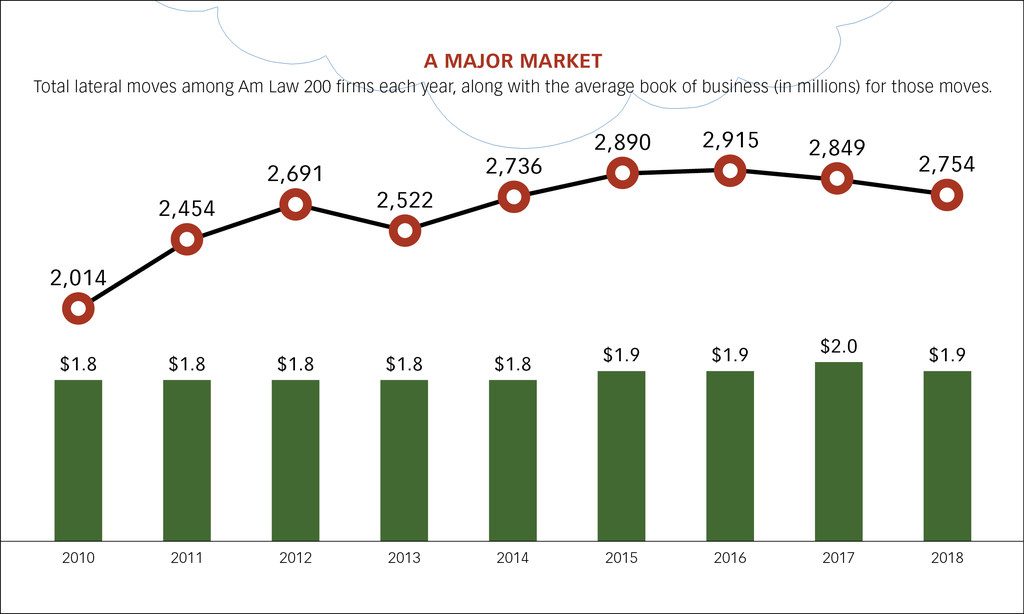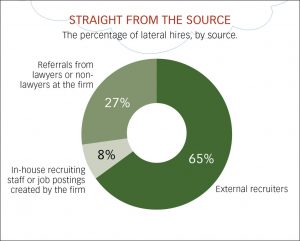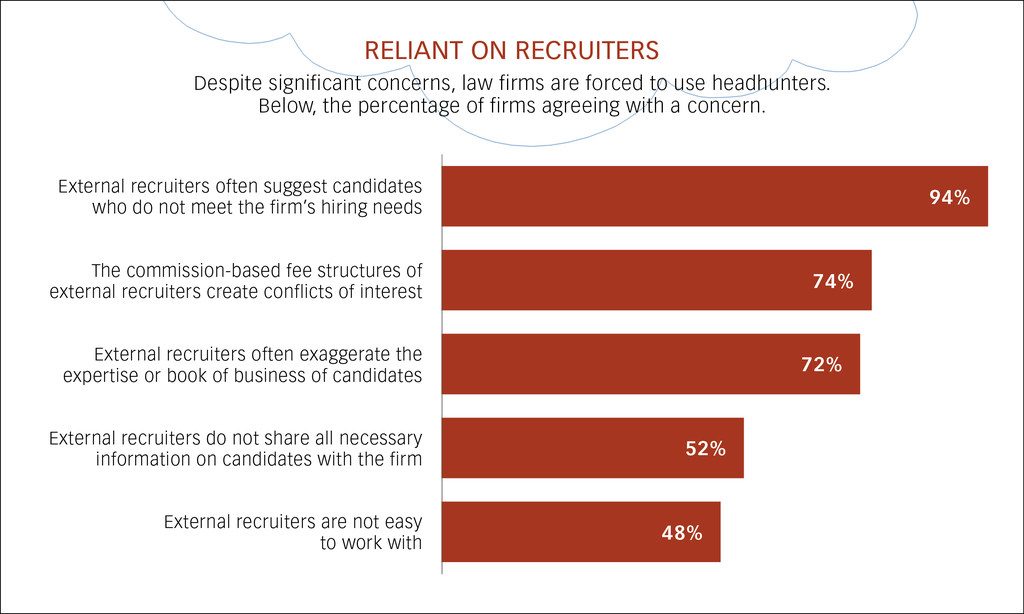It's Time to Overhaul the Lateral Hiring Process
Lateral partner hiring is characterized by big opportunities, big risks and low success rates. Law firms need a new approach.
January 29, 2019 at 03:30 PM
11 minute read
 Credit: Val Bochkov
Credit: Val Bochkov
Lateral hiring has become increasingly important to law firms' strategies and business models. The evidence for this statement is seemingly everywhere. In a recent survey conducted by ALM Intelligence and sponsored by competitive intelligence firm Decipher, 85 percent of Am Law 200 firms reported that hiring laterals was one of their two most important revenue growth strategies for the coming year. Conversations with managing partners support these findings. In interviews, they report that they are spending more time wooing laterals, and lateral hiring managers are moving up their organizational charts.
That lateral hiring is becoming more important should come as no surprise. In the slow growth environment that has characterized the post-recession era, law firms have had few options for growth. Clients are insourcing more and increasing their use of alternative service providers. This has dampened the opportunity for organic growth. Mergers are complicated and risky but are happening in record numbers. Laterals offer firms a more manageable opportunity for rapid growth while expanding into new markets, adding new services, developing new clients, and, most important, adding new books of business to support increased revenue.
Curiously, lateral hiring's rise in importance has not been matched with a corresponding increase in the sophistication of law firm lateral hiring programs. While some advancements have been made, most programs are, for all intents and purposes, the same as they were a decade ago. This is problematic. The cost of hiring a new partner is high. The success rates are low. Stories of misbehaving lateral partners are more prevalent than ever, revealing risks that need to be managed seriously. Most law firm leaders admit a new approach to lateral hiring is needed. So, where to begin?
A Key Source of Growth
Before starting, it might be useful to debunk a few myths about lateral partner hiring and add a bit of perspective so its importance can be better understood.
The first myth to debunk is that lateral hiring is only important to a small number of firms. In the five years from 2014 through 2018, there were almost 9,000 lateral partner moves from one Am Law 200 firm to another. While it is true that some firms do more hiring than others, no single firm accounts for more than 3 percent of the total moves among the Am Law 200. In fact, lateral partner hiring is much more common than most appreciate. Ninety-seven percent of Am Law 200 firms made a lateral partner hire in the past five years. Slightly more than half averaged at least one lateral every two months over that period, and one-quarter averaged at least one lateral per month. This is the equivalent of a firm completing one sizable acquisition per year.

The importance of lateral hiring to a law firm's growth strategy is also often understated. ALM Intelligence estimates that the average book of business for lateral partners in the past five years was close to $2 million. In total, an estimated $17.1 billion in business moved with partners through the lateral markets over the past five years. To put that into perspective, Am Law 200 firms grew their revenue by a total of $16.9 billion during that period.
For a firm looking to grow, the lateral partner market represents the single largest source of revenue growth potential. It offers more than rate increases, more than mergers, and even more than wooing new clients with baseball tickets, skiing trips or dinners out on the town. The revenue growth potential of hiring lateral partners with a book of business is bigger than all of those put together.
Low Success Rates, Big Risks
Here's the rub. While the opportunities available to law firms in the lateral market are huge, so are the risks. Success rates in lateral partner hiring among Am Law 200 firms are relatively low. Twenty-four percent of lateral partners leave the firm that hired them within three years. Nearly half leave within five years. Even worse, two-thirds of lateral hires won't produce 75 percent of their expected book of business. Given the average cost of hiring a lateral partner per year is $1.7 million (including basic salary, recruiting fees and onboarding costs), such low success rates are not trivial to a law firm's finances. Put simply, bad hiring decisions are costing law firms (and their partners) significant amounts of money.
 Then there are the other risks that most law firms don't like to talk about. Nearly everyone in the legal market has heard stories of “misbehaving” lateral partners. This polite euphemism is meant to describe a lateral partner hire who commits malpractice, sexual harassment, or some form of workplace harassment. To delve into these issues, ALM Intelligence held off-the-record conversations with nearly 50 major law firms. In those conversations, many firms admitted that they had faced difficulties with lateral hires in these areas. Conversations with insurance providers that underwrite law firms were even more revealing.
Then there are the other risks that most law firms don't like to talk about. Nearly everyone in the legal market has heard stories of “misbehaving” lateral partners. This polite euphemism is meant to describe a lateral partner hire who commits malpractice, sexual harassment, or some form of workplace harassment. To delve into these issues, ALM Intelligence held off-the-record conversations with nearly 50 major law firms. In those conversations, many firms admitted that they had faced difficulties with lateral hires in these areas. Conversations with insurance providers that underwrite law firms were even more revealing.
Insurance providers are arguably the best source of information on malpractice and workplace harassment, as they aggregate claims across multiple firms. Law firm leaders have a sense of the problem the industry faces. Insurance providers write the checks when things go wrong. One individual at a major insurance company that underwrites law firms against malpractice and workplace harassment claims summarized a view that nearly every insurance provider echoed: “Almost everyone in the insurance industry believes laterals represent a disproportionate number of claims,” the individual said.
Cases of malpractice, sexual harassment and workplace harassment carry significant risks for law firms. In terms of financial risks, the settlements in these types of cases can be large. More important, however, is the damage such cases do to law firms' branding and to the well-being of their employees. In an era of heightened awareness around interpersonal relations, as exemplified by the #MeToo movement, these risks should be keeping managing partners up at night.
To follow a conversation on this subject between Nicholas Bruch, director of ALM Intelligence, and Ben Seal, executive editor of The American Lawyer, beginning Tuesday, Feb. 5, register here:
A New Approach
The overwhelming takeaway from three months of research on lateral hiring is this: The opportunities are huge, the success rates are low, and the risks are real. Clearly, a new approach to hiring is needed.
The first step law firms must take is regaining control of their lateral hiring programs. In nearly every interview, law firms reported that their annual hiring calendar takes on a similar pattern each year. In November and December, firms set out their hiring priorities for the coming year and solidify a strategy. Then, the new year begins and resumes start pouring in from recruiters. Inevitably, a resume comes across that includes a big book of business or a client the firm has been pursuing. In many cases that resume doesn't meet the firm's previously defined strategy for hiring priorities. Some firms reported that they consistently pass on these opportunities in order to stay focused on their strategy. Most firms, however, do not.
Many firm leaders admitted their hiring programs are overly opportunistic and reliant on search firms. One head of talent at an Am Law 50 firm hesitantly admitted that his firm “gets distracted too easily,” adding, “it's something we have consistently struggled with.” This has to change. Recruiters are essential to firms' hiring programs. That said, they should be used as a tool to support a firm's strategy, not as a method of identifying opportunities. When resumes do not meet previously defined goals, they should be treated skeptically, with an assumption that the firm will not move forward with the candidate.

Law firms must also add more due diligence. Hiring a lateral partner is an investment that carries risks beyond the financial. Partners must be investigated in the same way a firm would vet any other investment. This includes understanding the financials of the partner's practice as well as understanding the work style and the way he or she treats colleagues and subordinates.
For most law firms, the lateral partner questionnaire is the beginning of the vetting process with target candidates. It often includes more than 50 questions and ends with the candidate's signature, attesting to the truth of the disclosures. Each and every questionnaire is unique, as each law firm designs its own to reflect its own development and culture. There is no industry standard.
Law firms need to review and redesign their questionnaire processes, which may result in tightening up the language used within the questionnaire to ensure internal compliance and best practices to prevent a bad hire.
To combat and eliminate risk, leading law firms are increasingly adding an additional section to the questionnaire that asks for permission to conduct criminal and financial background checks (subject to state and federal restrictions), as well as an investigative consumer report.
Until now, law firms have been hesitant to perform rigorous investigations on laterals for fear of offending potential hires. This hesitation is understandable. Hiring of any kind involves vetting and wooing. The hiring firm needs to assess if the candidate can perform the duties of the role. The candidate, on the other hand, wants to feel as though they are being courted. Unfortunately, investigations of these kinds are necessary. Candidates are going to have to accept that this is standard operating procedure if they want to join a partnership.
Law firm leaders have a responsibility to their partners to perform rigorous due diligence on lateral partner hires. From a fiduciary standpoint they must ensure the firm's money is being well spent. They also have a requirement to ensure the individuals being admitted into the partnership will not negatively impact the firm culture or put the firm at risk. Firm leaders also have a moral responsibility to their associates and staff to create a safe workplace.
The only way to fulfill these responsibilities is to perform an exhaustive and thorough investigation on each lateral partner candidate. The candidate's book of business must be examined to understand its profitability and portability. Additionally, the potential hire's business development skills should be assessed to determine if he or she is capable of rebuilding the practice should clients choose not to move to the new firm. Background checks must be done to identify red flags. Most important, interviews must be conducted with the candidate's past work colleagues to understand his or her work style and ensure there are no concerns about how he or she interacts with others.
Firms will balk at this last step. Interviewing is understandably controversial. Moving from one firm to another is a risky endeavor for partners, and the knowledge that a partner is thinking about changing firms is sensitive and should be treated with the utmost care. That said, there are ways to perform interviews without revealing the fact that a partner is considering a move.
Building a Business Case
These two changes—reducing firms' reliance on search firms and increasing the amount of due diligence done on candidates—offer many advantages to law firms. Taking greater control of the search process will make hiring programs more strategic and less opportunistic. More due diligence should help distinguish good hires from bad hires before decisions are made. There are less obvious benefits as well.
The intelligence gained in the due diligence process should help inform the business case and business plan for incoming partners. This, in turn, should help improve the integration process. If firms know more about a candidate ahead of time, they can build infrastructure around the candidate to ensure he or she can hit the ground running. The combination of a more strategic program, better due diligence, and improved integration could have big impacts on retention rates and revenue growth. Smart firms could then take the next step of branding themselves as a home where lateral partners can come to accelerate their practices.
Given the low success rates of most firms in the lateral hiring area, it wouldn't be hard to become a market leader in this space. All it takes is focus, diligence and management support.
Nicholas Bruch is principal analyst at ALM Intelligence and a member of Decipher's advisory board. Michael A. Ellenhorn is co-founder and general counsel of Decipher and Howard Rosenberg is its co-founder and CEO.
This content has been archived. It is available through our partners, LexisNexis® and Bloomberg Law.
To view this content, please continue to their sites.
Not a Lexis Subscriber?
Subscribe Now
Not a Bloomberg Law Subscriber?
Subscribe Now
NOT FOR REPRINT
© 2025 ALM Global, LLC, All Rights Reserved. Request academic re-use from www.copyright.com. All other uses, submit a request to [email protected]. For more information visit Asset & Logo Licensing.
You Might Like
View All
Greenberg Traurig Litigation Co-Chair Returning After Three Years as US Attorney
3 minute read
Blank Rome Snags Two Labor and Employment Partners From Stevens & Lee
4 minute read
12-Partner Team 'Surprises' Atlanta Firm’s Leaders With Exit to Launch New Reed Smith Office
4 minute read
After Breakaway From FisherBroyles, Pierson Ferdinand Bills $75M in First Year
5 minute readTrending Stories
- 1'A Death Sentence for TikTok'?: Litigators and Experts Weigh Impact of Potential Ban on Creators and Data Privacy
- 2Bribery Case Against Former Lt. Gov. Brian Benjamin Is Dropped
- 3‘Extremely Disturbing’: AI Firms Face Class Action by ‘Taskers’ Exposed to Traumatic Content
- 4State Appeals Court Revives BraunHagey Lawsuit Alleging $4.2M Unlawful Wire to China
- 5Invoking Trump, AG Bonta Reminds Lawyers of Duties to Noncitizens in Plea Dealing
Who Got The Work
J. Brugh Lower of Gibbons has entered an appearance for industrial equipment supplier Devco Corporation in a pending trademark infringement lawsuit. The suit, accusing the defendant of selling knock-off Graco products, was filed Dec. 18 in New Jersey District Court by Rivkin Radler on behalf of Graco Inc. and Graco Minnesota. The case, assigned to U.S. District Judge Zahid N. Quraishi, is 3:24-cv-11294, Graco Inc. et al v. Devco Corporation.
Who Got The Work
Rebecca Maller-Stein and Kent A. Yalowitz of Arnold & Porter Kaye Scholer have entered their appearances for Hanaco Venture Capital and its executives, Lior Prosor and David Frankel, in a pending securities lawsuit. The action, filed on Dec. 24 in New York Southern District Court by Zell, Aron & Co. on behalf of Goldeneye Advisors, accuses the defendants of negligently and fraudulently managing the plaintiff's $1 million investment. The case, assigned to U.S. District Judge Vernon S. Broderick, is 1:24-cv-09918, Goldeneye Advisors, LLC v. Hanaco Venture Capital, Ltd. et al.
Who Got The Work
Attorneys from A&O Shearman has stepped in as defense counsel for Toronto-Dominion Bank and other defendants in a pending securities class action. The suit, filed Dec. 11 in New York Southern District Court by Bleichmar Fonti & Auld, accuses the defendants of concealing the bank's 'pervasive' deficiencies in regards to its compliance with the Bank Secrecy Act and the quality of its anti-money laundering controls. The case, assigned to U.S. District Judge Arun Subramanian, is 1:24-cv-09445, Gonzalez v. The Toronto-Dominion Bank et al.
Who Got The Work
Crown Castle International, a Pennsylvania company providing shared communications infrastructure, has turned to Luke D. Wolf of Gordon Rees Scully Mansukhani to fend off a pending breach-of-contract lawsuit. The court action, filed Nov. 25 in Michigan Eastern District Court by Hooper Hathaway PC on behalf of The Town Residences LLC, accuses Crown Castle of failing to transfer approximately $30,000 in utility payments from T-Mobile in breach of a roof-top lease and assignment agreement. The case, assigned to U.S. District Judge Susan K. Declercq, is 2:24-cv-13131, The Town Residences LLC v. T-Mobile US, Inc. et al.
Who Got The Work
Wilfred P. Coronato and Daniel M. Schwartz of McCarter & English have stepped in as defense counsel to Electrolux Home Products Inc. in a pending product liability lawsuit. The court action, filed Nov. 26 in New York Eastern District Court by Poulos Lopiccolo PC and Nagel Rice LLP on behalf of David Stern, alleges that the defendant's refrigerators’ drawers and shelving repeatedly break and fall apart within months after purchase. The case, assigned to U.S. District Judge Joan M. Azrack, is 2:24-cv-08204, Stern v. Electrolux Home Products, Inc.
Featured Firms
Law Offices of Gary Martin Hays & Associates, P.C.
(470) 294-1674
Law Offices of Mark E. Salomone
(857) 444-6468
Smith & Hassler
(713) 739-1250









